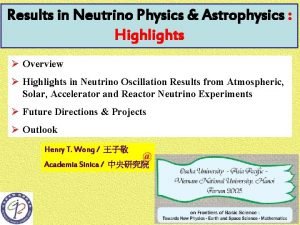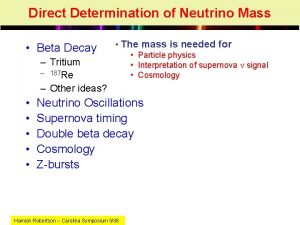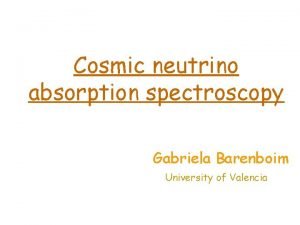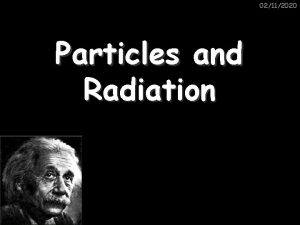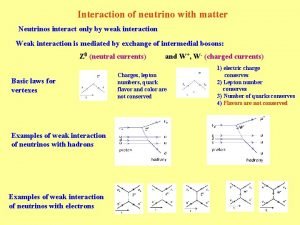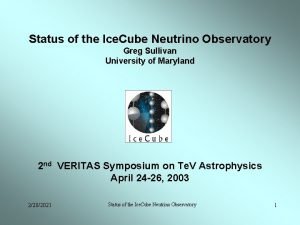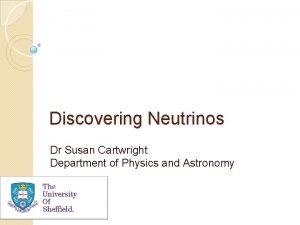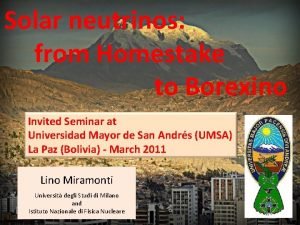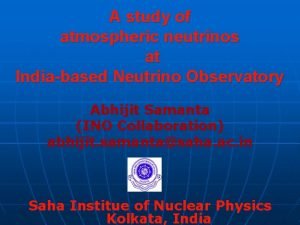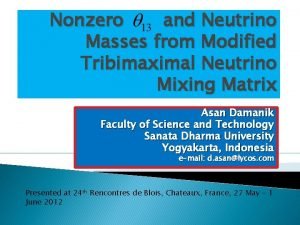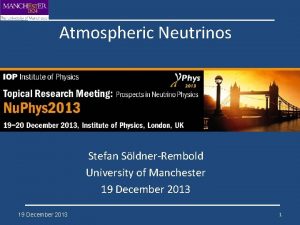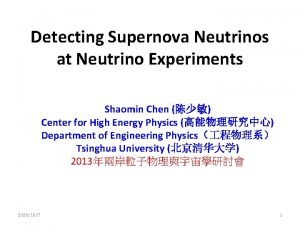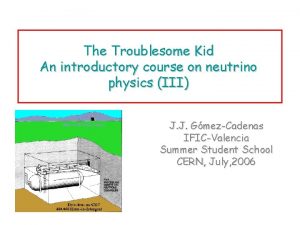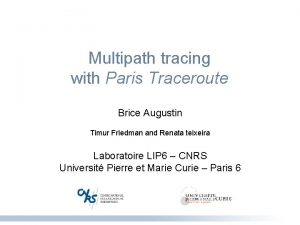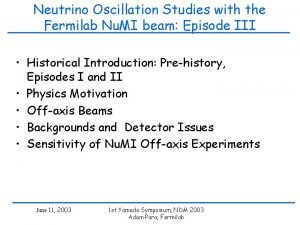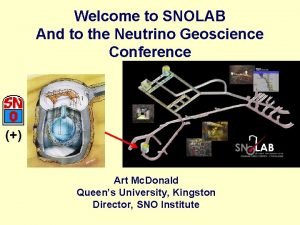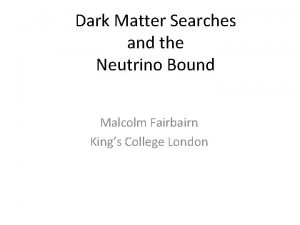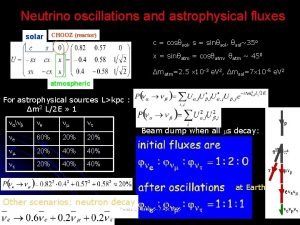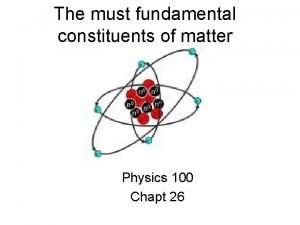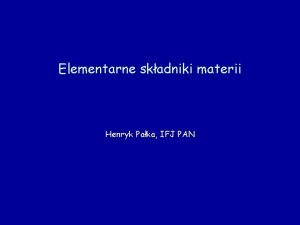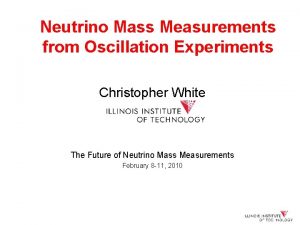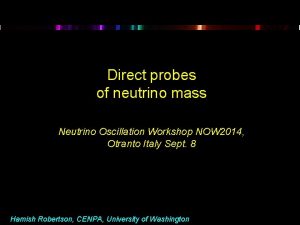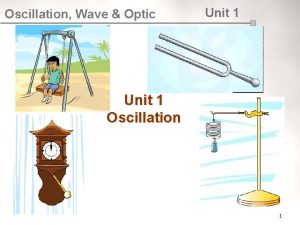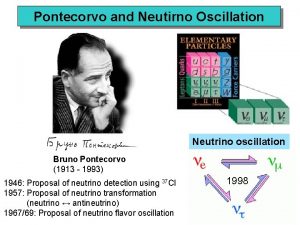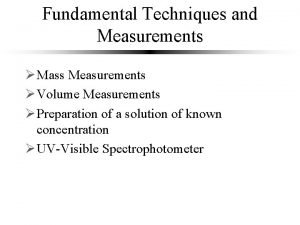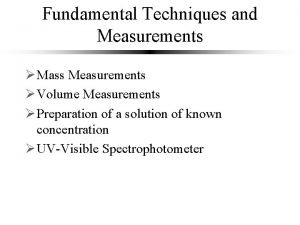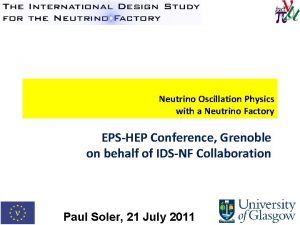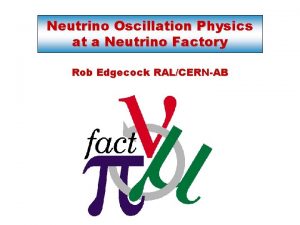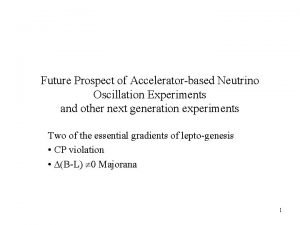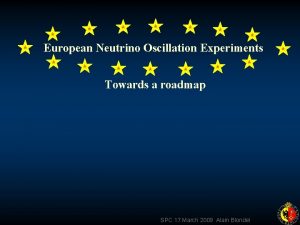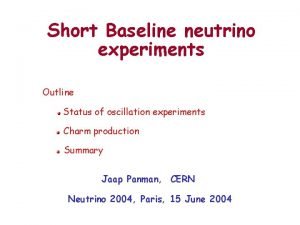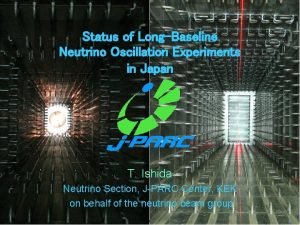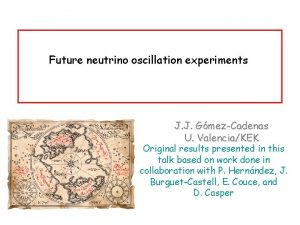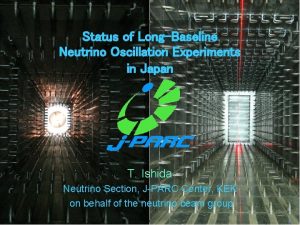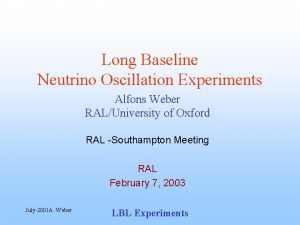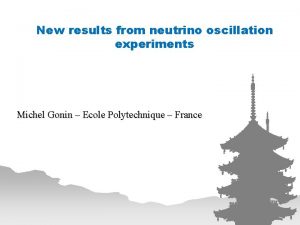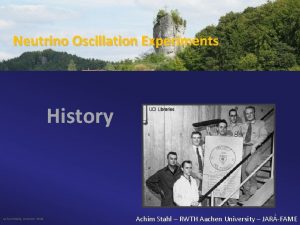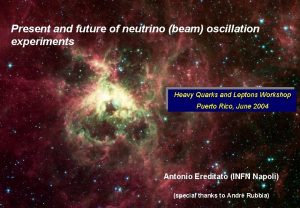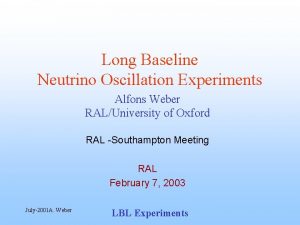Neutrino Mass Measurements from Oscillation Experiments Christopher White























- Slides: 23

Neutrino Mass Measurements from Oscillation Experiments Christopher White The Future of Neutrino Mass Measurements February 8 -11, 2010

Neutrino Oscillation Experiments measure flavor oscillations

Homestake Experiment was First… Davis experiment in Homestake mine Estimated rate: 10 atoms per week! Solar e + 37 Cl e- + 37 Ar Theoretical predictions 615 ton C 2 Cl 4 (bleaching solution) 1 SNU = 1 interaction/1036 target atoms/sec

Result considered a Failure 1968: Davis's initial results The much-touted experiment appears a failure. Davis announces that he has detected only about one third as many radioactive argon atoms as Bahcall predicted. Scientists call the discrepancy "The Solar Neutrino Problem. " The press calls it "The Mystery of the Missing Neutrinos. ” Decades of Doubt In the two decades following their disappointing results, Davis fine-tunes his solar neutrino detector, and Bahcall refines and checks his calculations. Hundreds of other physicists, chemists, and astronomers also examine Bahcall and Davis's work. No one can find significant fault with either the apparatus or the calculations. 1969: A possible explanation Physicists Vladimir Gribov and Bruno Pontecorvo, working in the Soviet Union, suggest that Davis and Bahcall's missing neutrinos can be explained by "neutrino oscillations"

Proton Decay Experiments (save the day) 1985: More missing particles In an experiment called Kamiokande, sited in the Kamioka Mozumi mine in Japan, Masatoshi Koshiba and colleagues detect far fewer atmospheric neutrinos than they expect to see. While atmospheric neutrinos are a different type from those produced by the sun, the so-called "atmospheric neutrino anomaly" is similar to the solar neutrino problem. Where are the missing neutrinos? One of 3 detectors to observe neutrinos from SN 1987 a

The Super-Kamiokande Collaboration MEDIA ADVISORY FOR JUNE 5, 1998 EVIDENCE FOR MASSIVE NEUTRINOS We announce today at "Neutrino '98", the international physics conference underway in Takayama, Japan, that the Super-Kamiokande Experiment has found evidence for non-zero neutrino mass. “Just yesterday in Japan, physicists announced a discovery that tiny neutrinos have mass. Now, that may not mean much to most Americans, but it may change our most fundamental theories -- from the nature of the smallest subatomic particles to how the universe itself works, and indeed how it expands. ”

Neutrino Mixing • If neutrinos have mass, it is possible that the weak eigenstates are not the same as the mass eigenstates: PMNS (Pontecorvo-Maki-Nakagawa-Sakata) matrix

More On Neutrino Mixing • Parametrize the mixing matrix as: solar reactor atmospheric • For reactor experiments, the probability of e e is: where

How Does It Work ? Sin 22 13 = 1 Sin 22 13 = 0. 2

Initial results do not provide strong bounds… but we know that the mass differences are small.

At this point, most experiments consisted of a single detector and could not control their neutrino source. Discovery Experiments SNO Super-K

But a new generation of oscillation experiments changed everything. Begin the era of precision oscillation experiments Kam. LAND

Accelerator Experiments Ø Ø Ø 1 m segmented graphite target Two magnetic focusing horns Moveable target relative to horn 1 (variable neutrino spectrum) Long decay region followed by absorbers ~95% m, ~4 % m, ~1. 3% e

MINOS OVERVIEW Ø Main Injector Neutrino Oscillation Search Ø Accelerator-based long-baseline neutrino experiment Ø Precision experiment at the atmospheric Dm 2 Ø One m beam: Nu. MI o 120 Ge. V protons from Fermilab Main Injector Ø Two detectors o Near Detector: measure beam composition and spectrum o Far Detector: search for evidence of oscillations

Identical Detectors NEAR DETECTOR • • 1 km from target 1 kton 282 steel planes 153 scintillator planes FAR DETECTOR • • 735 km from target 5. 4 kton 484 steel/scintillator planes GPS time-stamping to synchronise FD data to beam Steel/scintillator tracking calorimeters Functionally identical Magnetised to 1. 2 T

Statistics • Very large event rates in the Near Detector (~107 events in the fiducial volume for 1020 POT) à High-statistics dataset: – Understand performance of Near Detector – Check level of agreement between data and Monte Carlo Reconstructed y vertex (m) Distribution of reconstructed event vertices in the x-y plane Reconstructed track angle with respect to vertical Beam points down 3 degrees to reach Soudan Fiducial region Coil hole Partially instrumented planes Detector outline Reconstructed x vertex (m) Area normalized

MINOS DATA νμ Disappearance - Energy Spectrum This plot compares the 848 events in MINOS Far Detector (black points) to the expected neutrino energy distribution (1065 +- 60 events) in the absence of neutrino disappearance (red histogram). While most of the events are expected to be charged-current neutrino interactions, 5. 9 neutral current (NC) background events are expected (shaded histogram barely visible in bottom corner), as well as 1. 5 nu-tau interactions, 2. 3 events from upstream neutrino interactions in the rock, and 0. 7 cosmic ray events. The data showing a clear deficit relative to the expected rate, we fit these data for the hypothesis of two-flavor oscillations, and the black histogram shows the expected spectrum corresponding to Δm 2=(2. 43± 0. 11)x 10 -3 and sin 2(2Θ)=1. 00± 0. 05 which gives the best fit to the data, with a χ2/dof=90/97. 2/NDo. F = 90/97

Precision Results are now available

Neutrino Oscillation Data Summary Neutrino Mixing: PMNS Matrix Solar Kam. LAND 12 ~ 30º Reactor Accelerator 13 < 12º Atmospheric, K 2 K, MINOS, T 2 K, etc. 23 ~ 45º sin 2(2θ 23) >0. 92 Δm 322 = (2. 43 ± 0. 13) × 10− 3 e. V 2 sin 2(2θ 12) = 0. 87 ± 0. 03 Δm 212 = (7. 59 ± 0. 20) × 10− 5 e. V 2 sin 2(2θ 13) <0. 19 , CL=90% Unknown: sin 22 13, d. CP, Sign of Dm 232

Mass Hierarchy Δm 212 = (7. 59 ± 0. 20) × 10− 5 e. V 2 Δm 322 = (2. 43 ± 0. 13) × 10− 3 e. V 2

Intensity Frontier The Intensity Frontier, accessed with a combination of intense particle beams and highly sensitive detectors offers the possibility of observing 13 and resolving the hierarchy issue. T 2 K

Expected Sensitivity Pick your favorite start date… Sensitivity in sin 22 13 (90%CL) 0. 05 0. 04 0. 03 0. 02 0. 01 0. 0 1 2 3 4 5 Number of years of data taking

Thank You
 Neutrino mass
Neutrino mass Neutrino mass
Neutrino mass Reported speech cambios
Reported speech cambios Gabriela barenboim
Gabriela barenboim Neutrino lepton number
Neutrino lepton number Neutrino interaction with matter
Neutrino interaction with matter Ice cube para status
Ice cube para status Who discovered neutrino
Who discovered neutrino Solar neutrino
Solar neutrino Neutrino
Neutrino Neutrino
Neutrino Neutrino
Neutrino Neutrino
Neutrino Neutrino beteckning
Neutrino beteckning Solar neutrino
Solar neutrino Neutrino
Neutrino Paris traceroute
Paris traceroute Neutrino
Neutrino Cerenkov
Cerenkov Neutrino
Neutrino The leptons
The leptons Neutrino
Neutrino Neutrino symbol
Neutrino symbol Lekka cząstka elementarna mion elektron lub neutrino
Lekka cząstka elementarna mion elektron lub neutrino
